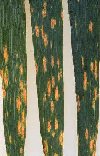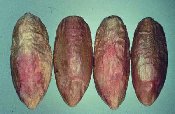| |
Tan Spot, Yellow Leaf Spot | |
| |
|
|
| |
|
|
| | Biology | Damage description | Management strategy
Pyrenophora tritici-repentis (asexual - Drechslera tritici-repentis)
Biology
Tan spot affects wheat as well as brome and wheat grasses. It occurs in all wheat growing areas of the Prairie Provinces. Rye and barley are rarely affected and oats are resistant.
The fungus overwinters on crop residue and fall sown wheat. Spores produced in early spring are moved by wind to infect other plants. Spores produced on infected leaves become primary sources of disease that are spread during prolonged wet periods. Seedlings may become infected but do not appear diseased until they head out.
Rain and dew encourage spore production and the release of spores from crop residue and existing leaf infections. To become infected, wheat leaves must remain wet for a minimum of six hours. The presence of leaf infections on the winter wheat in May or on spring sown crops in June could result in a rapid disease build-up if prolonged wet weather occurs.
Damage Description
Tan or brown flecks first appear on lower leaves. The flecks become lens-shaped, expand and join. The centres of the spots become dark brown. A zone of bright yellow tissue usually surrounds the dark brown centres. Heavily infected leaves may wither and die. Infected seed is usually smaller and shrivelled and may have a pinkish coloration.
Yield reductions result from loss of photosynthetic area, especially if flag leaves and heads are infected. Following high levels of disease, kernel weight may be lighter with a possible grade reduction for shrivelled and off-color seeds.
Management Strategy
- Follow a crop rotation that includes barley and oats, which are not good hosts of this disease or non-host crops such as canola, mustard, field pea, lentil, flax, corn, potatoes and alfalfa.
- Using tillage to bury wheat residue hastens decomposition which reduces the amount of surface straw that can produce air borne spores during the growing season. However, the benefits of minimum/conservation tillage to preserve soil moisture outweigh the risk of early disease development.
- Do not plant winter wheat on land adjacent to spring wheat that was infected with tan spot.
- Use a wide row spacing to reduce in-crop humidity.
- Apply a foliar fungicide. Consult the Crop Protection Guide for information on fungicides registered for leaf spot control in wheat.

Tan spot of wheat caused by Pyrenophora tritici repentis. Durum wheats are particularly susceptible.

Red smudge on durum wheat kernels caused by tan spot infection. Low levels of smudge could reduce the wheat in grade to sample. |
|
| |
|
|
| |
For more information about the content of this document, contact Neil Whatley.
This document is maintained by Mary Ann Nelson.
This information published to the web on November 16, 2001.
Last Reviewed/Revised on November 16, 2015.
|
|